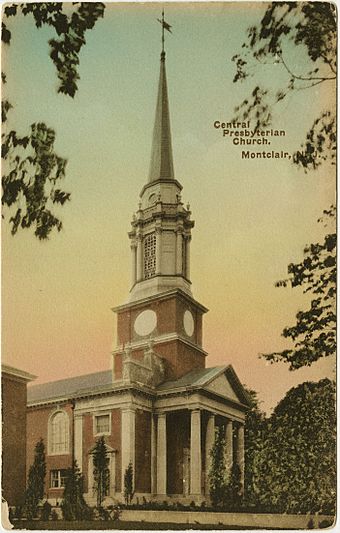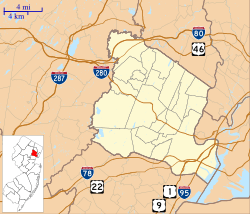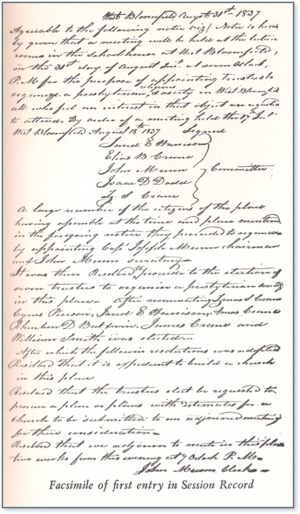Central Presbyterian Church (Montclair, New Jersey) facts for kids
|
Central Presbyterian Church
|
|

Central Presbyterian Church on a vintage postcard
|
|
| Location | 46 Park Street, Montclair, New Jersey |
|---|---|
| Built | 1921 |
| Architect | Carrere & Hastings; Shreve, Lamb & Harmon |
| Architectural style | Colonial Revival, Georgian Revival |
| MPS | Montclair MRA |
| NRHP reference No. | 86003051 |
Quick facts for kids Significant dates |
|
| Added to NRHP | November 14, 1986 |
The Central Presbyterian Church is a beautiful old church found at 46 Park Street in Montclair, New Jersey, United States. It is a special building with a long history.
This church was built in 1921. It was officially opened on October 15, 1922. The church was added to the National Register of Historic Places on November 14, 1986. This means it is an important building because of its amazing design. Famous architecture companies, Carrere & Hastings and Shreve, Lamb & Harmon, designed it.
The Church's Early Days
The story of this church began a long time ago, in 1837. A group of people met at a local schoolhouse. They decided to start a Presbyterian group for their town. This town was first called West Bloomfield. Later, in 1870, it became known as Montclair.
The schoolhouse where they met was fixed up. A wooden church was built right over the schoolrooms. This first church was in the middle of town. It was on a triangle-shaped block. This block was surrounded by Bloomfield Avenue, Park Street, and Church Street. The church was officially opened on August 9, 1838. Samuel Ware Fischer was the first pastor, serving from 1839 to 1849. He later became the President of Hamilton College.
Growing and Changing
As the town grew, the church needed more space. In 1860, a new and bigger building was built behind the first church. It was named The First Presbyterian Church of Montclair.
In 1867, the church bought the school next door. This allowed them to make the church even bigger. It could then hold up to 700 people. The new Township of Montclair held its very first board meeting in the church's lecture room in 1868.
Over the years, the church community changed. In 1886, some members disagreed about church rules. This led to a new church being formed, called Trinity Presbyterian Church. But later, on December 2, 1913, Trinity and Old First churches joined together. They officially became The Central Presbyterian Church of Montclair.
A brand new church building was built at the corner of Park Street and Claremont Avenue. This is the building you see today. It was officially opened on October 15, 1922. In 1950, Central Presbyterian Church made history. They were among the first to allow women to become elders in the church.
Images for kids









